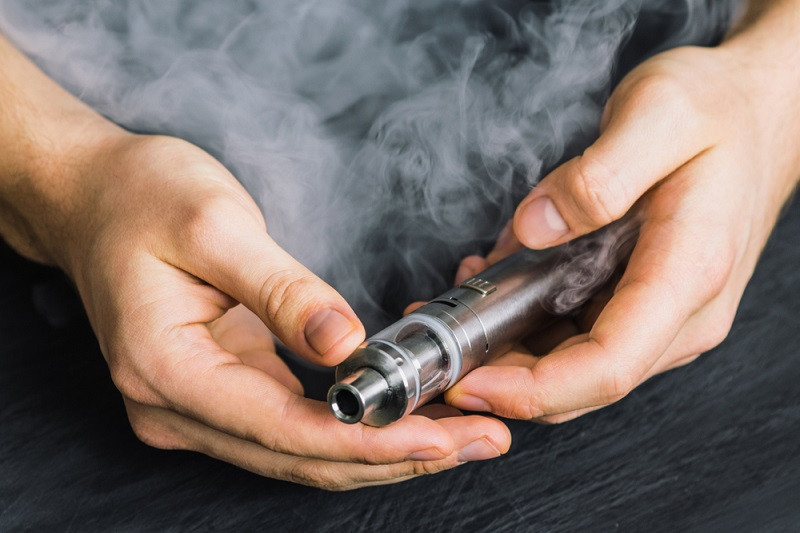Popular Reads
Top Results
Can't find what you're looking for?
View all search resultsPopular Reads
Top Results
Can't find what you're looking for?
View all search resultsHow dangerous is vaping? The science remains hazy
So what do we know for sure about electronic cigarettes?
Change text size
Gift Premium Articles
to Anyone
I
s vaping a useful tool for quitting smoking or just a new way of harming your health? Countries around the world are beginning to consider this question and India on Wednesday announced a total ban on the sale of e-cigarettes,
However such legislation is running ahead of scientific research into the issue. So what do we know for sure about electronic cigarettes?
What do e-cigarettes contain?
Vaping consists of inhaling the vapor of a heated liquid inside e-cigarettes.
That liquid normally contains nicotine, the highly addictive substance present in regular tobacco. Nicotine can effect brain development in the under-25s, according to some studies, and have a detrimental effect on adult brains.
However the liquids vaped do not include a number of dangerous substances found in cigarettes, such as carcinogenic tar and carbon monoxide, which can be a factor in cardiovascular diseases.
What e-cigarettes do contain are tiny particles which enter the lungs. There are "numerous potentially toxic substances," according to a report published last year by the US National Academies of Sciences.
Among these are metals such as nickel and lead, probably from the coil used to heat the liquid.
There are also additives considered safe in the agro-food industry but linked to pulmonary problems in their vaporized form or simply not studied at all with regard to vaping.
The different flavors offered by e-cigarette manufacturers include tobacco but also menthol, fruit, vanilla and even candy or creme brulee, some of which have led to accusations that they are aimed at youngsters.
So is vaping dangerous?
Researchers have little long-term perspective on the health issues of a product which has only been on the market since the mid-2000s.
For those who move from cigarettes to vaping, the scientific consensus is that they have chosen a less toxic alternative. They still get their nicotine fix but carcinogenic substances present in cigarettes are no longer inhaled.
"Even if it is difficult to quantify precisely the long-term toxicity of electronic cigarettes, there is evidence that it is significantly lower than traditional cigarettes," the French Academy of Medicine opined in 2015.
The World Health Organization has remained more cautious, saying that vaping is "probably less toxic" than smoking but that there was insufficient information to quantify the risks.
Can vaping help smokers to quit?
A British study published in February in the New England Journal of Medicine suggested that e-cigarettes are more efficient than patches, gum or other products in helping people to stop smoking cigarettes.
But, again, the WHO says there is insufficient proof of this effect and could vary according to the type of e-cigarettes adopted.
E-cigarette manufactures complain of "misinformation" being disseminated about their products, as do some anti-smoking specialists.
Read also: Vaping related lung disease claims third life in US
Young e-smokers
One of the concerns most often raised about vaping is that it attracts young people who have never even smoked cigarettes, encouraged by aggressive marketing and the variety of alcopops type flavours available.
They inhale the nicotine and studies show that vaping can in fact lead them to the more traditional cigarettes.
The protection of young people is one of the reasons cited by India for its ban on e-cigarettes.
"The decision was made keeping in mind the impact that e-cigarettes have on the youth of today," Finance Minister Nirmala Sitharaman told reporters in New Delhi.
In the United States, there is talk of a vaping epidemic in high schools, with the fruit-flavoured, mint and menthol versions predominating.
On Tuesday New York became the second US state, after Michigan, to ban the sale of flavoured e-cigarettes.
"It is undeniable that vaping companies are deliberately using flavors like bubblegum, Captain Crunch and cotton candy to get young people hooked on e-cigarettes—it's a public health crisis and it ends today," said New York Governor Andrew Cuomo.
President Donald Trump's administration announced last week that it would soon ban flavored e-cigarette products to stem the rising tide of young users.











